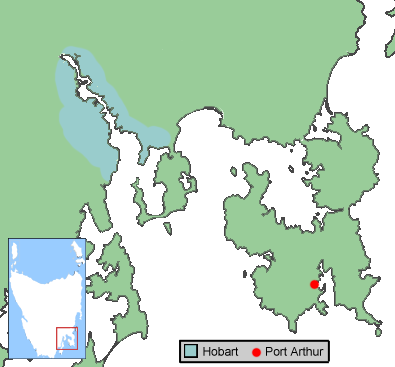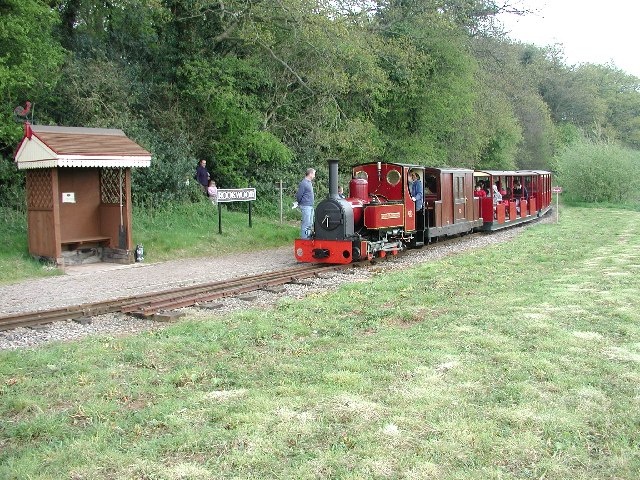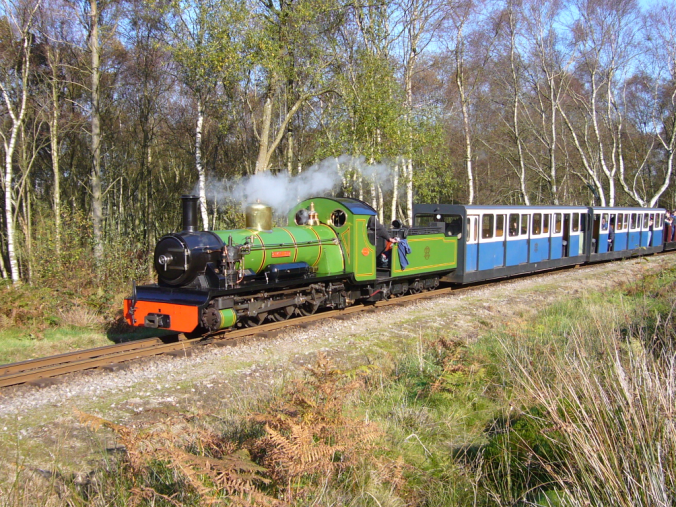|
Bush Mill Railway
The Bush Mill Railway was a gauge miniature railway, situated from Port Arthur, in Tasmania. It opened in 1986.The Railway News Vol.53 No.2 July 2004 p. 46 Route The Bush Mill Railway climbed steeply through a series of loops and zig zags up a hillside, then across a spectacular Serpentine Bridge. A half-size replica of the K1 was constructed to operate on the line in 1990. The prototype K1 was the world's first Garratt locomotive, built for the North-East Dundas Tramway on Tasmania's west coast. Settlement A replica settlement was established which featured a 19th-century sawmill and a number of items which were directly related to the logging tramways which once dotted much of Tasmania.The Railway News Vol.49 No.2 June/July, 1997 p. 50 It closed on 30 June 2004. Locomotives The Railway also had 5 semi-open coaches and 2 coal wagons, these became part of the collection at the Cleethorpes Coast Light Railway The Cleethorpes Coast Light Railway is a minimum- ... [...More Info...] [...Related Items...] OR: [Wikipedia] [Google] [Baidu] |
Ridable Miniature Railway
A ridable miniature railway (US: riding railroad or grand scale railroad) is a large scale, usually ground-level railway that hauls passengers using locomotives that are often models of full-sized railway locomotives (powered by diesel or petrol engines, live steam or electric motors). Overview Typically miniature railways have a rail track gauge between and under , though both larger and smaller gauges are used. At gauges of and less, the track is commonly raised above ground level. Flat cars are arranged with foot boards so that driver and passengers sit astride the track. The track is often multi-gauged, to accommodate , , and sometimes gauge locomotives. The smaller gauges of miniature railway track can also be portable and is generally / gauge on raised track or as / on ground level. Typically portable track is used to carry passengers at temporary events such as fêtes and summer fairs. Typically miniature lines are operated by not for profit organisations - often mod ... [...More Info...] [...Related Items...] OR: [Wikipedia] [Google] [Baidu] |
Port Arthur, Tasmania
Port Arthur is a town and former convict settlement on the Tasman Peninsula, in Tasmania, Australia. It is located approximately southeast of the state capital, Hobart. The site forms part of the Australian Convict Sites, a World Heritage property consisting of 11 remnant penal sites originally built within the British Empire during the 18th and 19th centuries on fertile Australian coastal strips. Collectively, these sites, including Port Arthur, are described by UNESCO as "... the best surviving examples of large-scale convict transportation and the colonial expansion of European powers through the presence and labour of convicts." In 1996, the town was the scene of the Port Arthur Massacre, the worst instance of mass murder in post-colonial Australian history. Location Port Arthur is located about southeast of the state capital, Hobart, on the Tasman Peninsula. The scenic drive from Hobart, via the Tasman Highway to Sorell and the Arthur Highway to Port Arthur, takes a ... [...More Info...] [...Related Items...] OR: [Wikipedia] [Google] [Baidu] |
Tasmania
) , nickname = , image_map = Tasmania in Australia.svg , map_caption = Location of Tasmania in AustraliaCoordinates: , subdivision_type = Country , subdivision_name = Australia , established_title = Before federation , established_date = Colony of Tasmania , established_title2 = Federation , established_date2 = 1 January 1901 , named_for = Abel Tasman , demonym = , capital = Hobart , largest_city = capital , coordinates = , admin_center = 29 local government areas , admin_center_type = Administration , leader_title1 = Monarch , leader_name1 = Charles III , leader_title2 = Governor , leader_name2 ... [...More Info...] [...Related Items...] OR: [Wikipedia] [Google] [Baidu] |
Bush Mill Gl
Bush commonly refers to: * Shrub, a small or medium woody plant Bush, Bushes, or the bush may also refer to: People * Bush (surname), including any of several people with that name ** Bush family, a prominent American family that includes: ***George H. W. Bush (1924–2018), former president of the United States ***George W. Bush (born 1946), former president of the United States and son of George H. W. Bush *** Jeb Bush (born 1953), former governor of Florida and candidate for US president ** Vannevar Bush (1890–1974), American engineer, inventor and science administrator ** Kate Bush (born 1958), British singer, songwriter, pianist, dancer, and record producer Places United States * Bush, Illinois * Bush, Louisiana * Bush, Washington * Bush, former name of the Ralph Waldo Emerson House in Concord, Massachusetts * The Bush (Alaska) *"The Bush," a small neighborhood within Chicago's community area of South Chicago Elsewhere * Bush, Cornwall, a hamlet in England * Bush Isl ... [...More Info...] [...Related Items...] OR: [Wikipedia] [Google] [Baidu] |
TGR K Class
The Tasmanian Government Railways K class was a class of 0-4-0+0-4-0 Garratt articulated steam locomotives operated by the Tasmanian Government Railways from 1909 – the first Garratt locomotives built. Overview Although considered the first Garratt locomotives, they did in fact differ in two important details from Herbert Garratt's original concept. First: they are compound locomotives, with two high-pressure cylinders on the rear engine, and a pipe leading to two larger low-pressure cylinders on the front engine; second: both sets of cylinders were placed facing each other inside their engine units, rather than facing out as in all other Garratts. This was a problem on the rare warm days on the West Coast Range in Tasmania, as one pair of cylinders was under the cab, making the cab uncomfortably hot. The North East Dundas Tramway on which they worked traversed some of the most rugged terrain in the world served by a railway at the time. It featured long stretches of 1-in- ... [...More Info...] [...Related Items...] OR: [Wikipedia] [Google] [Baidu] |
Beyer-Garratt
A Garratt (often referred to as a Beyer Garratt) is a type of steam locomotive invented by British engineer Herbert William Garratt that is articulated into three parts. Its boiler, firebox, and cab are mounted on a centre frame or "bridge". The two other parts, one at each end, have a pivot to support the central frame; they consist of a steam engine unit – with driving wheels, trailing wheels, valve gear, and cylinders, and above it, fuel and/or water storage. Articulation permits locomotives to negotiate curves that might restrict large rigid-framed locomotives. The design also provides more driving wheels per unit of locomotive weight, permitting operation on lightly engineered track. Garratt locomotives produced as much as twice the power output of the largest conventional locomotives of railways that introduced them, reducing the need for multiple locomotives and crews. Advantages of the Garratt concept The principal benefit of the Garratt design is that the boil ... [...More Info...] [...Related Items...] OR: [Wikipedia] [Google] [Baidu] |
North-East Dundas Tramway
The North East Dundas Tramway was a narrow gauge tramway, that ran between Zeehan and Deep Lead (now Williamsford) on the West Coast of Tasmania. Opening in 1896 and closing in 1932, it was part of the Tasmanian Government Railways network. The world's first Garratt locomotives, the K class, were used on the line. History Construction of the line to carry ore from the Williamsford mines to Zeehan, where it was loaded onto another train for shipment to Burnie commenced in January 1896, with the first section opened in December 1896. It opened in full on 18 June 1898. The narrow-gauge (2 ft) was chosen because of the extremely difficult terrain that the railway crossed, requiring several big trestle bridges, including one at the foot of Montezuma Falls. After some rain the engine and carriages would get soaked by spray from the falls. A detailed description of conditions along the line is included in a report of a journey undertaken in 1900 by the Fitzroy Australian ... [...More Info...] [...Related Items...] OR: [Wikipedia] [Google] [Baidu] |
Perrygrove Railway
Perrygrove Railway is a heritage railway of gauge. It is located at Perrygrove Farm in the Forest of Dean, near Coleford, Gloucestershire, England. Trains travel at frequent intervals on a round trip of between four stations. Passengers can ride on the train to use activities including a Treetop Adventure, a covered picnic and play area at Foxy Hollow, an Indoor Village with secret passages, and a den-building area in the woods. The railway was inspired by the minimum gauge estate railways or British narrow gauge railways developed by Sir Arthur Heywood at the end of the 19th century, including his pioneering Duffield Bank Railway and the later Eaton Hall Railway. Until mid 2014, based at Perrygrove were the Heywood Collection and associated replica vehicles built by James Waterfield, including the locomotive "Ursula" and the Duffield Bank Dining Carriage. These are now in private storage offsite. Locomotives Steam Diesel Guest 4w-6DM "Dreadnought" of 1960. Dismantl ... [...More Info...] [...Related Items...] OR: [Wikipedia] [Google] [Baidu] |
Garratt
A Garratt (often referred to as a Beyer Garratt) is a type of steam locomotive invented by British engineer Herbert William Garratt that is articulated into three parts. Its boiler, firebox, and cab are mounted on a centre frame or "bridge". The two other parts, one at each end, have a pivot to support the central frame; they consist of a steam engine unit – with driving wheels, trailing wheels, valve gear, and cylinders, and above it, fuel and/or water storage. Articulation permits locomotives to negotiate curves that might restrict large rigid-framed locomotives. The design also provides more driving wheels per unit of locomotive weight, permitting operation on lightly engineered track. Garratt locomotives produced as much as twice the power output of the largest conventional locomotives of railways that introduced them, reducing the need for multiple locomotives and crews. Advantages of the Garratt concept The principal benefit of the Garratt design is that the boil ... [...More Info...] [...Related Items...] OR: [Wikipedia] [Google] [Baidu] |
Ravenglass And Eskdale Railway
The Ravenglass and Eskdale Railway is a minimum gauge heritage railway in Cumbria, England. The line runs from Ravenglass to Dalegarth Station near Boot in the valley of Eskdale, in the Lake District. At Ravenglass the line ends at Ravenglass railway station on the Cumbrian Coast Line. Intermediate stations and halts are at Muncaster Mill, Miteside, Murthwaite, Irton Road, The Green, Fisherground and Beckfoot. The railway is owned by a private company and supported by a preservation society. The oldest locomotive is ''River Irt'', parts of which date from 1894, while the newest is the diesel-hydraulic '' Douglas Ferreira'', built in 2005. The line is known locally as ''La'al Ratty'' and its gauge predecessor as ''Owd Ratty''. Nearby attractions include: the Roman Bath House at Ravenglass; the Hardknott Roman Fort, known to the Romans as ''Mediobogdum'', at the foot of Hardknott Pass; the watermills at Boot and Muncaster; and Muncaster Castle, the home of the Pen ... [...More Info...] [...Related Items...] OR: [Wikipedia] [Google] [Baidu] |
Romney, Hythe And Dymchurch Railway
The Romney, Hythe and Dymchurch Railway (RH&DR) is a gauge light railway in Kent, England, operating steam and internal combustion locomotives. The line runs from the Cinque Port of Hythe via Dymchurch, St. Mary's Bay, New Romney and Romney Sands to Dungeness, close to Dungeness nuclear power station and Dungeness Lighthouse. History Planning The railway was the dream of millionaire racing drivers Captain John Edwards Presgrave ("Jack") Howey and Count Louis Zborowski. The latter had constructed a railway at Higham Park, his home at Bridge, Kent, and agreed to donate the rolling stock and infrastructure to the project. However, he was killed on 19 October 1924 in a motor racing accident at the Monza Grand Prix before the Romney Marsh site was chosen, and Howey continued the project alone. After Howey had unsuccessfully attempted to buy the Ravenglass & Eskdale Railway and extend it, he investigated a greenfield site between Burnham-on-Sea and Weston-super-Mare in Somers ... [...More Info...] [...Related Items...] OR: [Wikipedia] [Google] [Baidu] |
Cleethorpes Coast Light Railway
The Cleethorpes Coast Light Railway is a minimum-gauge railway that primarily serves holidaymakers in Cleethorpes, North East Lincolnshire, England. It operates from near the Cleethorpes Leisure Centre, running to the mouth of the Buck Beck. History The CCLR began as the ''Cleethorpes Miniature Railway'' in 1948, and ran for a distance of near the sea front in Cleethorpes. The line was relocated and extended the following year, and between 1949 and 1971 ran southwards for from ''Cleethorpes Town'' to ''Thrunscoe'' (near the current ''Discovery Halt''). The line was extended at both ends in 1972: the northern terminus was relocated slightly closer to the town centre, while at its southern end it now ran as far as the Zoo. It became the Cleethorpes Coast Light Railway when it was privatised in 1991, and the new company renamed the termini ''Kingsway'' and ''Witts End''. ''Witts End'' (located at zoo, which by this time had closed to visitors) was abandoned in 1994, and a ne ... [...More Info...] [...Related Items...] OR: [Wikipedia] [Google] [Baidu] |





.jpg)


